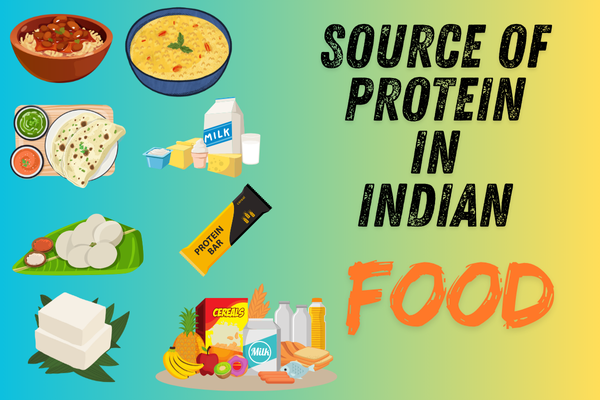🌱 Source of Protein in Indian Food: Authentic, Natural & Balanced

In a country known for its diverse vegetarian cuisine, many people wonder: Where do Indians get their protein from? The answer lies in a variety of traditional foods that are both nutrient-dense and culturally rooted. Whether you’re a vegetarian, vegan, or non-vegetarian, Indian food offers abundant natural protein sources that are often overlooked.
Let’s explore the most authentic and natural sources of protein in Indian food, many of which have been part of our diets for centuries.
🥣 1. Dals and Pulses – The Everyday Protein Heroes
Lentils and pulses are the backbone of Indian meals. Varieties like moong, masoor, toor, chana, and urad dal are consumed daily across regions.
✅ Protein Content:
Moong dal: ~24g/100g (raw)
Masoor dal: ~25g/100g
Chana dal: ~21g/100g
💡 Pro Tip: Combine dal with rice or roti to make a complete protein meal that includes all essential amino acids.
🧀 2. Paneer – Vegetarian Protein Powerhouse
Paneer or Indian cottage cheese is a rich source of protein and calcium.
✅ Protein Content: ~18g/100g
🌱 Vegetarian-friendly and made fresh at home using just milk and lemon juice.
💡 Try dishes like Paneer Bhurji, Paneer Butter Masala, or Grilled Paneer Tikka for both flavor and protein.
🫘 3. Rajma & Chole – Hearty, Wholesome, High-Protein
These legumes are protein-rich and fiber-packed, perfect for heart health and muscle repair.
✅ Protein Content:
Rajma (Kidney Beans): ~24g/100g
Chole (Chickpeas): ~19g/100g
💡 Best served with brown rice or roti for a filling, protein-rich meal.
🌿 4. Soya Chunks and Tofu – Vegan Protein Champions
Soya is a complete protein source and excellent for muscle growth.
✅ Protein Content:
Soya Chunks: ~52g/100g (dry)
Tofu: ~8g/100g
💡 Add soya to biryani, curries, or stir-fries. Tofu works well in matar tofu (pea curry) or pan-seared with Indian spices.
🥜 5. Nuts and Seeds – Small but Mighty
Indian kitchens use peanuts, almonds, flaxseeds, and sesame seeds in chutneys, snacks, and sweets.
✅ Protein Content:
Peanuts: ~25g/100g
Sesame seeds: ~18g/100g
Flaxseeds: ~18g/100g
💡 Make peanut chutney, add flaxseed powder to chapati dough, or enjoy sesame til laddoos.
🌾 6. Whole Grains – Balanced Energy + Protein
Grains like millets, wheat, and brown rice provide moderate protein and energy.
✅ Protein Content:
Bajra: ~11g/100g
Ragi: ~7g/100g
Whole wheat flour: ~12g/100g
💡 Add millets to your meals through khichdi, upma, or rotis to improve both fiber and protein intake.
🥛 7. Curd, Buttermilk & Lassi – Gut-Healthy Proteins
Fermented dairy is not only rich in protein but also improves digestion and immunity.
✅ Protein Content: ~3–4g/100g (curd)
💡 Enjoy curd with rice, turn it into chaas (buttermilk), or sip on sweet or salted lassi.
🥬 8. Green Leafy Vegetables – Modest but Valuable
Leafy vegetables like drumstick leaves, methi, and palak are underrated protein sources.
✅ Protein Content:
Drumstick leaves: ~9g/100g
Spinach (palak): ~2.8g/100g
💡 Add to curries, parathas, or soups for an extra protein and mineral boost.
🍳 9. Eggs and Fish – Non-Vegetarian Staples
For those who eat animal products, eggs and fish are protein-rich and versatile.
✅ Protein Content:
Egg: ~6g per egg
Fish (Rohu, Hilsa, etc.): ~20–22g/100g
💡 Try boiled eggs with masala, fish curry, or grilled fish with lemon and spices.
✅ Summary: Balanced Protein in Indian Diet
| Food Category | Example Items | Avg. Protein per 100g |
|---|---|---|
| Pulses & Legumes | Moong, Rajma, Chana | 20–25g |
| Dairy | Paneer, Curd | 4–18g |
| Soya Products | Tofu, Soya Chunks | 8–52g |
| Grains | Bajra, Ragi, Wheat | 7–12g |
| Nuts & Seeds | Peanuts, Flaxseeds | 18–25g |
| Greens | Drumstick, Spinach | 3–9g |
| Eggs & Fish | Egg, Rohu | 6–22g |
🧠 Pro Tip for Indian Meals:
Combine:
Grains + Legumes (e.g., Dal-Chawal, Roti-Chole)
Dairy + Grains (e.g., Paneer-Paratha)
Seeds + Veggies (e.g., Til in Palak)
…to create a complete, protein-rich meal using traditional Indian food!
🔚 Final Thoughts
Indian cuisine, with its rich variety of dals, grains, dairy, and seeds, naturally supports protein diversity and balance.
“Let food be thy medicine and medicine be thy food.” – This ancient wisdom holds especially true in the Indian kitchen.
Frequently Asked Questions:
